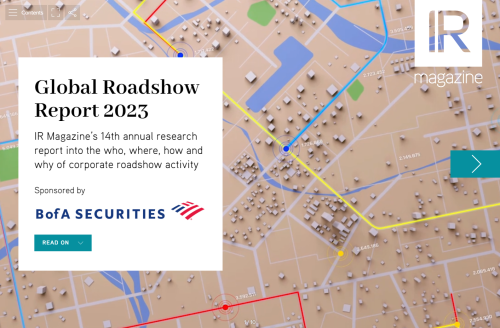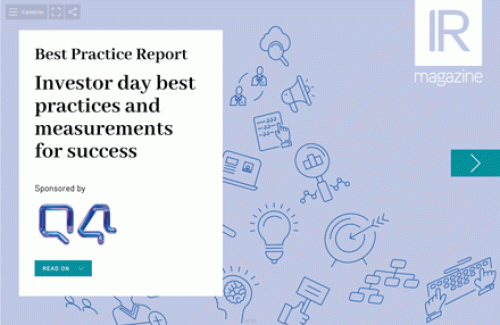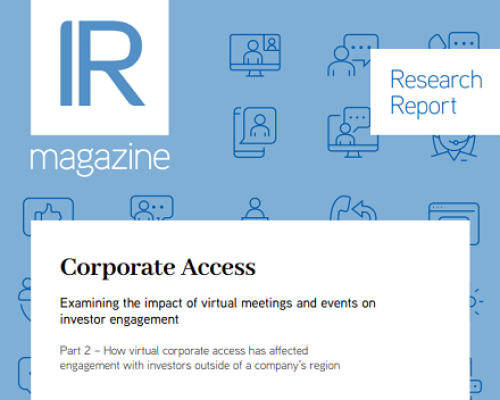The London event included panels on buy-side trends and best practice IR, plus a crisis simulation
Investors in the hot seat: changing buy-side perspectives in a harsh economy
‘You’re seeing the amount of money being put into active equities becoming less and less. You’re also seeing mandates in the fund management industry moving away from being country-specific. The first thing you have to focus on is access to the global fund managers, some of which are running massive funds, anything up to $80 bn-$100 bn. The second thing is Asia. We think the investment industry – the mutual fund industry, the private pension fund industry – will grow very significantly and if you look at a five-to-eight-year time horizon, those funds are going to be very important members of your shareholder base.’
‘I suspect the idea that there will be very big demand for actively managed equities from the emerging markets is going to be wrong. These are low-income countries. They want low-cost, transparent products that fit with local regulations, and I think that’s probably going to mean passive products if you’re in the equity space, more than active products.’
‘Exchange-traded funds (ETFs) started in Canada about 20 years ago. The global market is now around $1.7 tn in size and, I think more importantly, the growth rate over the last 10 years has been more than 25 percent. There seems to be an ETF for any kind of exposure investors would like to achieve. And because they are quite liquid, they are easy to get in and out of. I can have a portfolio of just ETFs, and I can manage that portfolio actively.’
‘I think we talk a lot about the short term when talking about top-down and asset allocation, but if we move further down to the stock-picking world, what has been very striking over the last three to four years is that portfolio managers on the continent have been running more and more concentrated portfolios and holding stocks for longer. They are now much more into long-term investment whereas they would have been more into trading a few years ago.’
The IRO panel: coverage, best practices and corporate development
‘There are not too many analysts if they do a good job. The problem is some of them just won’t allocate enough time to you – and that’s a little bit how we allocate time to them. You obviously cannot ignore any one of them because they are out there writing reports on your company, but we will definitely focus our efforts on half of them, 15 analysts or so with whom we have at least a monthly discussion. For the rest, it’s on more of an ad-hoc basis and there are a few of them you sometimes forget are following your story.’
‘We’re still skeptical about social media; not 100 percent skeptical – I understand this area is a growing topic – but so far we just use them as another channel to push information. We don’t have a Twitter account. The communications team does but it’s generally for corporate stuff – the team will tweet our results and push certain press releases. When I talk to investors, my experience is that social media are not yet an important channel for them, either. They present more risk than opportunity today.’
‘When I speak to companies that are looking into an IPO, and trying to build up an IR franchise, one of my first pieces of advice is to raise your profile internally and make sure management takes the IR role seriously. I have spent a lot of my time trying to extend my network within the company and get it to trust me, rely on me and look for me when there is something new happening.’
‘Our corporate strategy was revised in 2006: back then we simplified it into four bullet points, and today we still use basically the same bullet points. That is something the investment community appreciates: that we have a very consistent way of presenting and operating. When it comes to presenting the story, whatever the channel, we have put an emphasis on keeping it simple. It was quite a Christmas tree when we started.’
Crisis management: interactive case study and role play
Attendees played the role of an IRO at Wagaluu, a fictional biotech company listed in 2010 on the London Stock Exchange. A crisis develops when several patients die from infections at a hospital where Wagaluu is holding trials of a new spray-on bandage product. An equity analyst, lawyer, IR professional, investor and financial communications expert were on hand to explain how they would respond to the situation.
The investor
‘The CEO should know right now. Given that this is a small company and was listed only in 2010, there seems to be some key man risk here. The CEO needs to be informed because if he/she is at a cocktail party and I happen to be there, and I decide to ask him/her for any information on this situation and he/she comes across as clueless, I’m dumping the stock right there.’
The sell-side analyst
‘In a situation like this, ultimately my responsibility is: what is the company worth? So we’re looking at the financial and mathematical impact. I’m going to remind myself in my conversation with the IRO about the cash position, because from previous events in the industry I can probably estimate a liability. We regularly try to arrange calls with specialists in the areas we look at, and this would definitely be an opportunity to do so. Clearly, and particularly after events in America, we have very strict rules on engaging with so-called expert networks.’
The lawyer
‘You need to be clear about what you can say, what you really can’t say and maybe what you should be saying – but it’s the gray area in the middle that’s really difficult. We all agree it’s not inside information yet, but it could very quickly become inside information, so what are your obligations? If it is a product problem, there could potentially be litigation down the line, so what shouldn’t you be saying now in terms of admission of liability? What you can do, of course, is give a holding statement saying you’re looking into the situation.’
The financial communications expert
‘I think there’s an awful lot to be said from a social media standpoint of understanding what normal looks like. Even if we’re not necessarily doing anything proactive with it, that level of intelligence is valuable. So if there is some noise on Twitter around this discussion, we can start monitoring that conversation using tools and look at how it shifts over time. We can also drill down to look at which media outlets on a local or international level might be aware of it.’
The IR professional
‘We do around four crisis drills a year, and we’ve even done some of these very scenarios with our clients. If you don’t do this already, I highly recommend it, as we’ve been doing these for the last few years and every time you do it you realize there are different things that need to be taken into consideration. When we first did it we got into heated, almost physical fights with the operations people. They wanted us to stop asking questions they thought weren’t important, and we had to explain why they were important to investors. And the operations people responded that the investors can go jump in the lake because we’ve got lives at risk here!’
About IR Magazine Think Tanks
IR Magazine Think Tanks are invitation-only events for select groups of corporate IROs. The next one will be in Palo Alto, California on April 4. Find out about that and other upcoming think tanks in London, Toronto, Chicago and New York at www.irmagazine.com/events.










